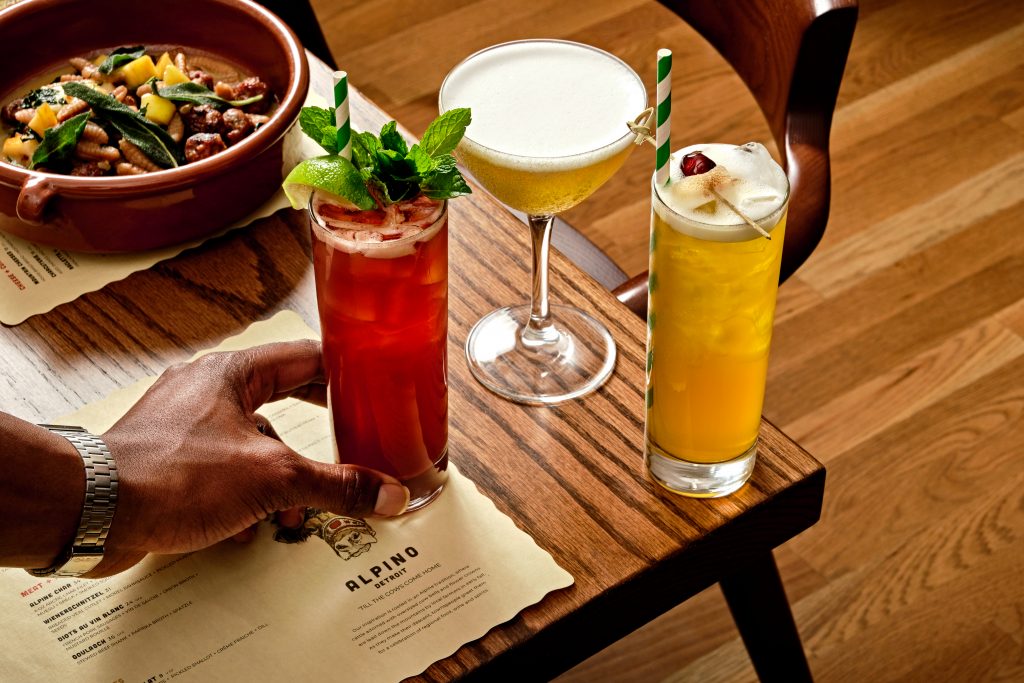No matter how hungry I am when I go to , I always leave absolutely stuffed. This past winter particularly, the restaurant had a feeling so easy to lean into as a Michigander, a feeling that says you’re home for the holidays, and it’s time to feast. There’s a leaping wood fireplace and close-quarters seating that evokes the extended-family dinner table. As I found out, it’s all by design
.
When Sterling Heights-born restaurateur David Richter returned to his home state from New York with the concept for Alpino in 2019, he hoped locals might feel a connection to cuisine from the Alps, and he was right.
‚ÄúIt‚Äôs a cuisine that has four seasons, just like we have here,‚ÄĚ says Richter, who is of Italian descent and has taken numerous trips to the Italian and French Alps since 2004.
‚ÄúSome of the fish here in Michigan that people are familiar with you‚Äôd find in the lakes and rivers in the Alps. It‚Äôs all fresh water; it‚Äôs not oceanside. Same with game birds and venison.‚ÄĚ
The long booths with community-style tables are, in fact, intended to generate conversations between strangers. In a less social, post-COVID world, it‚Äôs refreshing; Richter calls it ‚Äúa community of one under one roof.‚ÄĚ
On a February afternoon, I chatted with Richter and Executive Chef Colin Campbell at a window booth in Alpino before service. Richter is upbeat and gregarious. He can speak passionately and at great length about a range of topics (food, wine, history, music, etc.). Beyond his jovial and friendly nature, you get the sense of a mind immersed in small details.
His interest in Alpine cuisine was sparked more than two decades ago. In 2000, he worked as the manager and assistant beverage director at Esca, an Italian seafood eatery in Manhattan’s theater district. That’s where he fell in love with the distinct aroma of a dry Muscat from , a castle-filled region in northwestern Italy atop the Western Alps bordered by France and Switzerland.

From there, he began to research northern Italian foods ‚ÄĒ and became fascinated with the intersecting cultures connected by the mountain range spanning eight countries, as told through food.
‚ÄúYou‚Äôd run across a dish that was written in German, but also in Italian,‚ÄĚ Richter says. ‚ÄúI started seeing similarities in cuisines and thought, ‚ÄėNobody‚Äôs really tackled this ‚ÄĒ the backbone of Europe.‚Äô‚ÄĚ
This intersection is exemplified perfectly in the raclette, Alpino’s take on the traditional cheese dish born in Switzerland and served across Europe.
From a hot platter, the server scrapes a small avalanche of French raclette cheese onto a soft brioche slice, which is drizzled with a touch of honey and piled with ultrathin speck. It hits all the right notes. The brioche lays a buttery foundation. The speck (a fancier cousin of bacon, from Italy’s South Tyrol province) adds a smoky, savory bite, rounded out by the sweet and floral honey. The cheese is sharp and creamy, only enhanced by the flavor of browned bits raked from the bottom of the sizzling plate.
At Alpino, there‚Äôs more than enough cheese to go around. It made me realize that what we think of as ‚ÄúSwiss cheese‚ÄĚ in the States (Emmentaler) is just a tiny sliver of what the region has to offer (there are so many Swiss cheeses: rahmtaler, Schallenberg, rockflower ‚ÄĒ the list goes on).
‚ÄúYou could just do a whole menu on the cheeses from that part of the world paired with wines, andŐżthat alone would be its own little menu,‚ÄĚ Richter says.
Alpino’s wine list includes a good mix of economical and special-occasion bottles. There’s a heavy Italian presence, with additional selections from France, Germany, and Austria.

The cocktail program is headed by Detroit native Andre Sykes, whose beverage skills earned Detroit’s a James Beard Award semifinalist nod in 2022.
His signature mixes incorporate a diverse selection of Alpine flavors, like pine syrup and spiced pear. There are also Alpine spirits; lots of vermouths. However, you may be introduced to the less familiar: Ever tried génépi, the absinthe-like herbal aperitif invented in French Savoy?
The front-of-house staff is quite attentive, but the service also feels pleasantly relaxed. Everyone knows their stuff ‚ÄĒ they can tell you all about the ingredients, and some of my favorite dishes so far have been server-recommended. But then again, it helps when the food isn‚Äôt a hard sell.
‚ÄúVery early on, David and I talked about his vision ‚ÄĒ these heirloom recipes, rustic stuff,‚ÄĚ Campbell says. ‚Äú[The current menu] may be slightly more elevated than what he pictured in his mind. But doing very honest, good food was where I wanted
to be at ‚ÄĒ not trying to be super modern with everything. It‚Äôs very rewarding.‚ÄĚ
The Wiener shnitzel, fluffy and delicate, is spiritually true to the Austrian dish believed to have originated sometime in the 18th century, often reserved for holidays and other special occasions.
Chef Campbell is no stranger to schnitzel, having spent countless hours hammering away at cutlets in the prep kitchen at , a German restaurant in Marquette, his first gig out of culinary school at Northern Michigan University.
The flattened veal cutlet is coated in flour, dipped in D√ľsseldorf mustard-infused egg wash, covered in breadcrumbs, deep-fried to a lovely golden brown, and served with a lemon wedge. If it stopped there, it would be a classic, delicious Wiener schnitzel.

But there‚Äôs more: It‚Äôs ladled with rahmsauce (made with morels occasionally foraged from the Michigan wilderness by local purveyor Stoney Creek Mushrooms), a German cream gravy, which traditionally goes on a j√§gerschnitzel, ‚Äúbut it‚Äôs so good,‚ÄĚ Campbell says.
On top is a shaved cremini mushroom salad with mustard seed vinaigrette. The extra toppings are designed to elevate the dish, while also giving native Austrians and Germans and other Europeans from the region ‚Äúsomething that‚Äôs very similar to what they grew up eating,‚ÄĚ Campbell says.
Richter says they‚Äôve had several people from Alpine countries say the restaurant reminds them of home. ‚ÄúAnd it‚Äôs feedback that I didn‚Äôt think was going to happen. I thought it would just be like, we‚Äôve created a cool concept that people are going to love. It‚Äôs resonated with a lot of folks deeper than we thought in the beginning, which is great.‚ÄĚ
The previous two occupants of in Corktown (Lady of the House and St. CeCe‚Äôs Pub) were Irish restaurants ‚ÄĒ and Alpino still has fragments of the building‚Äôs Irish history. It has the same wooden door, engraved with what look like Celtic designs, framed by a cobblestone facade.
Despite its Irish origins, the entrance easily passes for an ancient woodland home on a mountain. The wood fireplace inside once had stones chiseled with the names of counties of Ireland, which Richter removed and donated to the nearby and Irish American Club of Detroit.
The interior is bright and cozy, with light walls, reclaimed cypress beams, and lots of natural wood tones. There are fur-covered chairs by the fireplace. On the mantel hangs a painting of Alpino’s mascot, a cow with flowers coming out of its head. There’s a story behind it.
‚ÄúIn Alpine towns, a lot of the cattle graze high up on the Alpine mountains all summer long,‚ÄĚ Richter says. ‚ÄúAt the end of the season, the cattlemen bring them down, and they parade them through the streets with a flower crown on their head. It symbolizes the season‚Äôs over, and then it usually turns into a festival.‚ÄĚ

One dish that encapsulates the feeling of a fall harvest is the seasonal chestnut gnocchetti, earthy and soothing. The first thing I tasted was the fried sage, which added herbaceous overtones to the hearty pasta dish, which features wild boar sausage, apple, kale, and melty Morbier cheese. The gnocchetti (similar to gnocchi) is made with chestnut flour, a popular base for pastas in northern Italy.
The dessert menu moves away from rustic flavors and enters avant-garde territory ‚ÄĒ like a drummer playing a thunderous solo at the end of a gig during which they had been holding back the whole time. When I took my first bite of the herb torte, a server asked, ‚ÄúIsn‚Äôt it so surprising?‚ÄĚ I had to agree.
The round cake is soft, crumbly. It‚Äôs sweet and botanical, baked with an Alpine blend of herbs including basil, tarragon, parsley, and chives. On top are tiny slices of a pear soaked in mulled wine (gl√ľhwein), diplomat cream, and candied nuts. There‚Äôs not much to compare it to as far as the flavor combination ‚ÄĒ just know it‚Äôs delicious and you‚Äôre in for a ride.
I was intrigued to hear about Samantha Hamrick, Alpino‚Äôs pastry chef (she has ‚ÄúCAKE LOVE‚ÄĚ tattooed on her knuckles), who was busy prepping for Valentine‚Äôs Day during my interview with Richter and Campbell.
‚ÄúShe‚Äôs always been passionate about cakes and pastries,‚ÄĚ Campbell says. ‚ÄúShe‚Äôs very in tune, very up to date. She‚Äôs great with flavor, has a very advanced palate and a strong desire for creativity.‚ÄĚ
Hamrick initially joined the opening crew as a floor manager and helped write the first wine menu, including the tech sheets for staff training, before taking over the pastry chef position months later. She‚Äôs always tweaking recipes and introducing new desserts ‚ÄĒ I‚Äôm excited to try what she whips up next.
It’s worth noting that during the making of this review, Alpino made it to the semifinalist round of the James Beard Awards in the best new restaurant category. After the announcement, business was already starting to pick up.
‚Äú[James Beard recognition] has definitely been a goal of mine for the majority of my career,‚ÄĚ Campbell says. ‚ÄúI moved down here two years ago [from Charlevoix] with the back-of-my-mind intention of pushing for that. My past jobs have been in small cities. So it was nice to see it come so quickly.‚ÄĚ
Richter shares his staff’s excitement, but he still finds himself waking up in the middle of the night on a regular basis, thinking about the speech he’d give if Alpino won. The next round of nominations is April 3. If my experiences at Alpino are any indication, he may need to have that speech prepared.

Őż
Alpine Folk
Alpino‚Äôs Cellar Roots music series features folk music (roots, Americana, blues, banjos, fiddles, etc.), which Richter calls ‚Äúan underserved genre of music in Detroit, at least for my short time living back here.‚ÄĚ He spent nearly a decade in management at City Winery, a New York City eatery and event space that hosted some major acts in Richter‚Äôs time (Prince played a surprise show there to a crowd of 500 people in 2013).
Alpino‚Äôs small basement venue can seat only about 40 people and contains a bar and tables with full service. The space makes for a quiet, up-close way to appreciate music. I caught Gories co-founder Danny Kroha‚Äôs set in early February. As he fingerpicked a hypnotic rendition of ‚ÄúHouse of the Rising Sun,‚ÄĚ I started to imagine what it might have been like to see a folk show in 1960s Greenwich Village.
At a Glance
- Price: $$$
- Vibes: Relaxing, cozy, social, fun
- Service: Friendly, helpful, attentive
- Sound level: Moderate, with an excellent music playlist curated by Richter himself
- Dress code: Business casual
- Open: Dinner daily, plus Sunday brunch from 11 a.m.Őżto 3 p.m.
- Reservations: Highly recommended. Call 313-524-0888 or reserve online at .
- Parking: There’s a free on-site parking lot (a big plus).
- Accessibility: The main dining area is wheelchair accessible.
This story originally appeared in the April 2024 issue of ¬ť∂Ļ∑¨ļŇ Detroit magazine. To read more, pick up a copy of ¬ť∂Ļ∑¨ļŇ Detroit at a local retail outlet. OurŐżdigital editionŐżwill be available on April 5.
|
| Őż |
|








